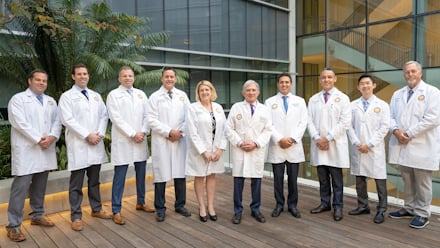Minimally Invasive Spine Surgery
Depending on the diagnosis, minimally invasive spine surgery uses a variety of technologies such as lasers, endoscopes, operating microscopes, and computer-assisted navigation systems.
This includes the Mazor X Stealth Edition System, which allows for computerized surgical planning, 3-D assessment of spine anatomy, plus robotic guidance and live feedback to ensure the highest degree of accuracy during surgery.
UC San Diego Health is a leader in minimally invasive spine surgery and trains surgeons nationwide in these techniques.
Advantages of Minimally Invasive Spine Surgery
- Shorter surgery
- Less anesthesia
- No blood transfusion
- Easier rehabilitation
- Less post-operative pain; fewer pain medications
- Minimal blood loss
- Smaller scars; smaller incision
- Less damage to muscle and skin
- Shorter hospital stay; outpatient surgery for some procedures
Types of Minimally Invasive Spine Surgery
Anterior cervical discectomy is done to reduce pressure and discomfort by removing a herniated cervical disc through a small incision in the front of the neck. The space where the disc was can be filled with bone graft material. Plates or screws can also be implanted to increase stability.
Anterior longitudinal ligament resection (ALL resection) is for the minimally invasive correction of kyphosis and deformity. The procedure spares the need for fusion and preserves mobility.
Anterior lumbar interbody fusion (ALIF) involves removing a disc through an incision in the front of the body in the abdomen. The disc is replaced with a spacer that usually contains bone graft material and will fuse with the surrounding vertebra. Screws, plates rods can also be implanted for additional stability and support.
Artificial cervical disc replacement or total disc replacement (TDR) involves removing most or all of a disc and replacing it with an artificial disc.
Complex minimally invasive surgery with lateral approach is performed on the side of the body, taking a less invasive approach than traditional back surgery, and can be used to help treat a variety of conditions and diseases including degenerative disc disease, disc herniations, spinal instability, osteomyelitis (discitis), spondylolisthesis and scoliosis.
En bloc resection removes a tumor in a single piece and is used to eliminate primary tumors located in the bones of the spine or next to the spine.
Endoscopic discectomy is done by making a small incision and using a tiny camera (an endoscope) to remove part of a herniated disc that is pressing on spinal nerves and causing pain.
Extreme lateral interbody fusion (XLIF) is performed on the side of the body so the nerves and muscles of the back are less affected, and involves removing a disc and replacing it with a spacer that will fuse with the two surrounding vertebra. Screws, plates, rods can also be implanted to help increase support and stability in the spine.
Lateral lumbar interbody fusion allows a minimally invasive correction of most deformity including scoliosis, kyphosis or trauma. Using your own disc space, correction is made with a custom spacer that goes into the disc space and at exactly the angle degree you need. The surgery follows normal tissue planes, preserves your muscle function and can be performed through incisions that are 3 inches or less in length.
Kyphoplasty is done to treat compression fractures in the spine that can result from osteoporosis. It is done by inserting a tiny balloon into the vertebrae and injecting cement into the space created by the balloon, helping to fill in the fractured bone.
Laminectomy is done to decrease pressure on the spine by removing all, or nearly all, of the lamina, which is the thin bony layer that covers the top of the spinal cord.
Laminotomy helps decrease spinal pressure by removing a portion of the lamina, which is the thin bony layer that covers the top of the spinal cord.
Laser discectomy uses a small laser to vaporize and remove a small portion of tissue from the center of a disc that is causing pain, helping reduce the size of disc and decrease pain and pressure in the spine.
Percutaneous posterior pedicle screw fixation involves attaching metal rods alongside the vertebrae to help stabilize the spine.
Microendoscopic discectomy is done by making the smallest incision possible and using a tiny camera (an endoscope) to remove part of a herniated disc that is pressing on spinal nerves and causing pain.
Minimally invasive surgical corpectomy is an outpatient procedure that relieves pressure on the spinal cord. This is done through a two inch incision.
Mini ALIF is essentially the same type of spinal fusion procedure as anterior lumbar interbody fusion, but is done through a smaller incision in the front of the body to remove a disc and replace it with a spacer that will fuse with surrounding vertebra to increase spinal stability.
Pedicle subtraction osteotomy involves removing a triangle of bone from the back of the vertebra so the spine can be shifted backwards.
Posterior cervical microforaminotomy (PCMF) helps relieve pressure and discomfort in the neck and cervical spine by clearing away excess scar tissue, bone and disc material, through a small incision in the back of the neck.
Smith-Petersen osteotomy is performed by removing portions of bone from the back of the spine and can be used to help restore correct curvature in the spine.
Thoracotomy is back surgery that is performed through an incision in the chest.
Transforaminal lumbar interbody fusion (TLIF) is performed slightly to the side of the patient’s body so that nerves and muscles in the back are less affected. A disc is removed and replaced with a spacer that will fuse with the two surrounding vertebra. Screws, plates and rods can also be implanted to increase support and stability in the spine.
Video-assisted thoracoscopic surgery (VATS) is performed through a small incision in the chest, using a tiny camera attached to a tube to guide the procedure.

